2015.5 Peugeot 308 brakes
[x] Cancel search: brakesPage 24 of 396
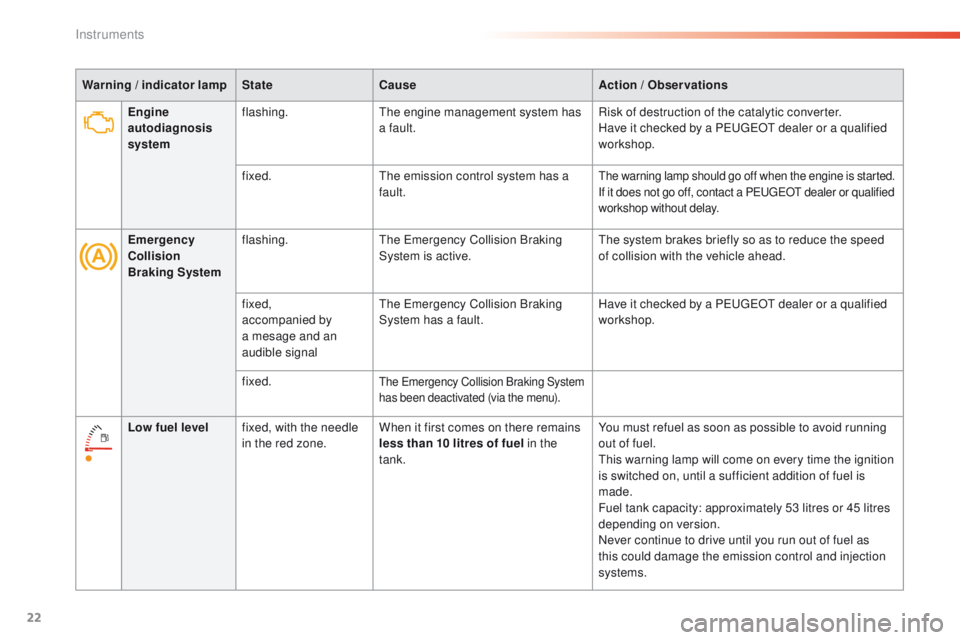
22
Engine
autodiagnosis
systemflashing.the
engine management system has
a fault. Risk of destruction of the catalytic converter.
Have it checked by a Pe
ugeOt dealer or a qualified
workshop.
fixed.
th
e emission control system has a
fault.
the warning lamp should go off when the engine is started.
If it does not go off, contact a Pe ugeOt dealer or qualified
workshop without delay.
Emergency
Collision
Braking System flashing.the
em ergency Collision Braking
System is active.th e system brakes briefly so as to reduce the speed
of collision with the vehicle ahead.
fixed,
accompanied by
a mesage and an
audible signal
the
e
m
ergency Collision Braking
System has a fault. Have it checked by a P
e
uge
Ot
dealer or a qualified
workshop.
fixed.
the emergency Collision Braking System
has been deactivated (via the menu).
Warning / indicator lamp State Cause Action / Observations
Low fuel level fixed, with the needle
in the red zone. When it first comes on there remains
less than 10 litres of fuel
in the
tank. You must refuel as soon as possible to avoid running
out of fuel.
th
is warning lamp will come on every time the ignition
is switched on, until a sufficient addition of fuel is
made.
Fuel tank capacity: approximately 53 litres or 45 litres
depending on version.
Never continue to drive until you run out of fuel as
this could damage the emission control and injection
systems.
Instruments
Page 122 of 396
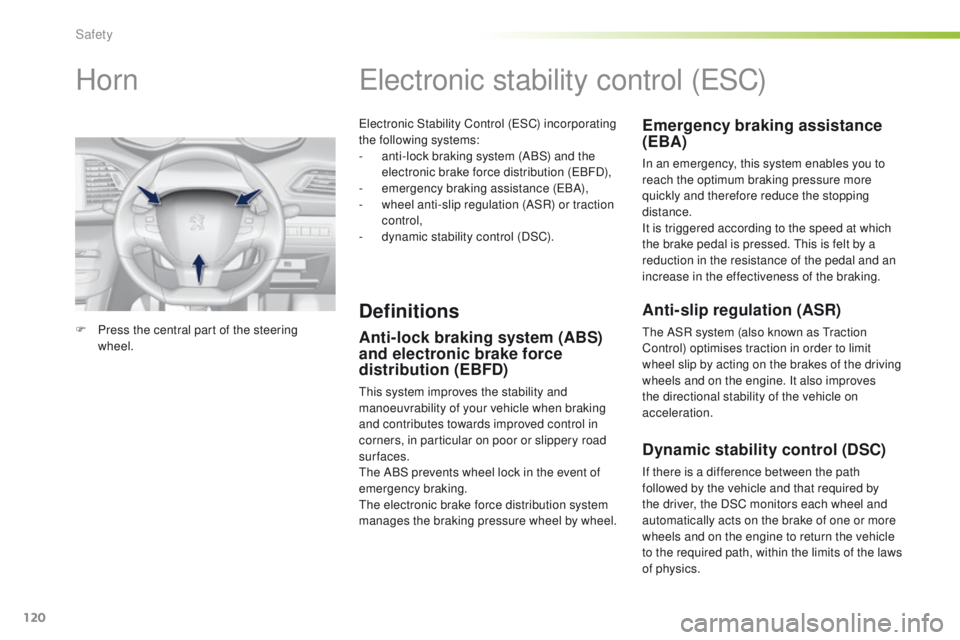
120
electronic Stability Control (eSC) incorporating
the following systems:
-
a
nti-lock braking system (ABS) and the
electronic brake force distribution (
eB
FD),
-
em
ergency braking assistance (
eBA
),
-
w
heel anti-slip regulation (ASR) or traction
control,
-
d
ynamic stability control (DSC).
electronic stability control (eS C)
Definitions
Anti-lock braking system (ABS)
and electronic brake force
distribution (EBFD)
this system improves the stability and
manoeuvrability of your vehicle when braking
and contributes towards improved control in
corners, in particular on poor or slippery road
surfaces.
th
e ABS prevents wheel lock in the event of
emergency braking.
th
e electronic brake force distribution system
manages the braking pressure wheel by wheel.
Emergency braking assistance
(EBA)
In an emergency, this system enables you to
reach the optimum braking pressure more
quickly and therefore reduce the stopping
distance.
It is triggered according to the speed at which
the brake pedal is pressed.
t
h
is is felt by a
reduction in the resistance of the pedal and an
increase in the effectiveness of the braking.
Anti-slip regulation (ASR)
the ASR system (also known as tr action
Control) optimises traction in order to limit
wheel slip by acting on the brakes of the driving
wheels and on the engine. It also improves
the directional stability of the vehicle on
acceleration.
Dynamic stability control (DSC)
If there is a difference between the path
followed by the vehicle and that required by
the driver, the DSC monitors each wheel and
automatically acts on the brake of one or more
wheels and on the engine to return the vehicle
to the required path, within the limits of the laws
of physics.
Horn
F Press the central part of the steering wheel.
Safety
Page 124 of 396
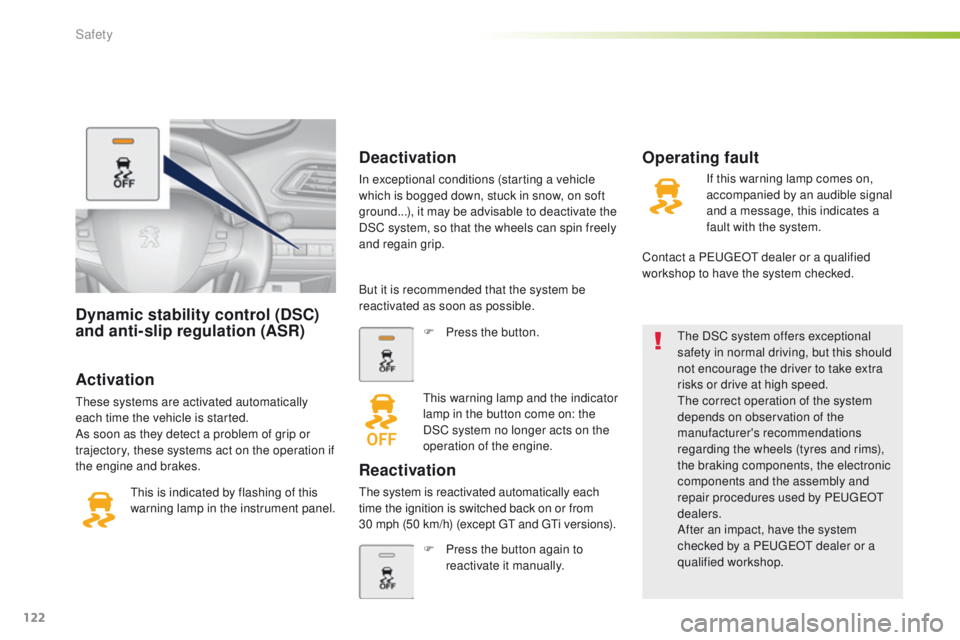
122
Dynamic stability control (DSC)
and anti-slip regulation (ASR)
Activation
these systems are activated automatically
each time the vehicle is started.
As soon as they detect a problem of grip or
trajectory, these systems act on the operation if
the engine and brakes.
th
is is indicated by flashing of this
warning lamp in the instrument panel.
th
e DSC system offers exceptional
safety in normal driving, but this should
not encourage the driver to take extra
risks or drive at high speed.th e correct operation of the system
depends on observation of the
manufacturer's recommendations
regarding the wheels (tyres and rims),
the braking components, the electronic
components and the assembly and
repair procedures used by P
e
uge
Ot
dealers.
After an impact, have the system
checked by a P
e
uge
Ot
dealer or a
qualified workshop.
Deactivation
In exceptional conditions (starting a vehicle
which is bogged down, stuck in snow, on soft
ground...), it may be advisable to deactivate the
DSC system, so that the wheels can spin freely
and regain grip.
Operating fault
But it is recommended that the system be
reactivated as soon as possible.
F
P
ress the button.
th
is warning lamp and the indicator
lamp in the button come on: the
DSC system no longer acts on the
operation of the engine.
Reactivation
the system is reactivated automatically each
time the ignition is switched back on or from
30 mph (50 km/h) (except
gt and gt
i v
ersions).
F
P
ress the button again to
reactivate it manually. If this warning lamp comes on,
accompanied by an audible signal
and a message, this indicates a
fault with the system.
Contact a P
e
uge
Ot
dealer or a qualified
workshop to have the system checked.
Safety
Page 149 of 396
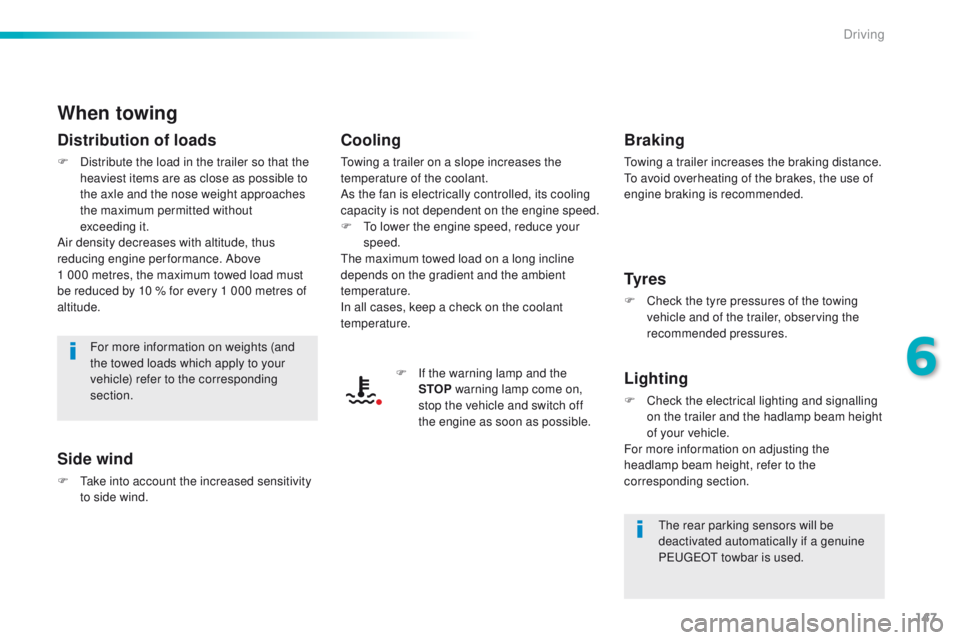
147
When towing
Distribution of loads
F Distribute the load in the trailer so that the heaviest items are as close as possible to
the axle and the nose weight approaches
the maximum permitted without
exceeding
it.
Air density decreases with altitude, thus
reducing engine performance. Above
1
000 metres, the maximum towed load must
be reduced by 10
% for every 1 000 metres of
altitude.
Side wind
F take into account the increased sensitivity to side wind.
Cooling
towing a trailer on a slope increases the
temperature of the coolant.
As the fan is electrically controlled, its cooling
capacity is not dependent on the engine speed.
F
t
o l
ower the engine speed, reduce your
speed.
th
e maximum towed load on a long incline
depends on the gradient and the ambient
temperature.
In all cases, keep a check on the coolant
temperature.
F
I
f the warning lamp and the
STOP warning lamp come on,
stop the vehicle and switch off
the engine as soon as possible.
Braking
towing a trailer increases the braking distance.to a void overheating of the brakes, the use of
engine braking is recommended.
Ty r e s
F Check the tyre pressures of the towing vehicle and of the trailer, observing the
recommended pressures.
Lighting
F Check the electrical lighting and signalling on the trailer and the hadlamp beam height
of your vehicle.
For more information on adjusting the
headlamp beam height, refer to the
corresponding section.
For more information on weights (and
the towed loads which apply to your
vehicle) refer to the corresponding
section.
th
e rear parking sensors will be
deactivated automatically if a genuine
P
e
uge
Ot
towbar is used.
6
Driving
Page 168 of 396
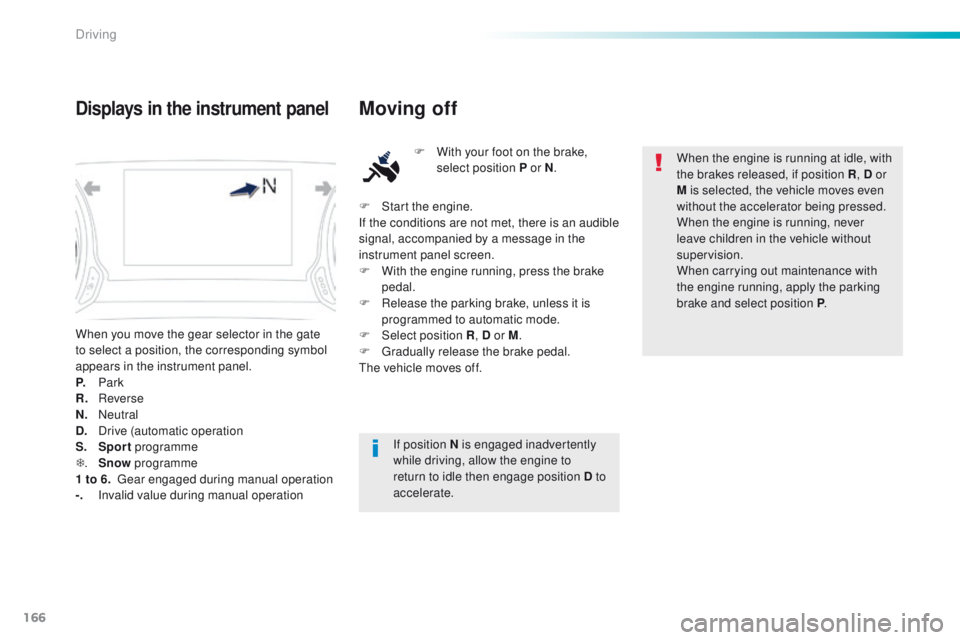
166
When you move the gear selector in the gate
to select a position, the corresponding symbol
appears in the instrument panel.
P.
Park
R.
R
everse
N.
N
eutral
D.
D
rive (automatic operation
S.
Sport programme
T .
S
now programme
1 to 6.
g
ea
r engaged during manual operation
-.
I
nvalid value during manual operation
Displays in the instrument panelMoving off
F With your foot on the brake, select position P or N .
If position N is engaged inadvertently
while driving, allow the engine to
return to idle then engage position D to
accelerate. When the engine is running at idle, with
the brakes released, if position R
, D or
M is selected, the vehicle moves even
without the accelerator being pressed.
When the engine is running, never
leave children in the vehicle without
supervision.
When carrying out maintenance with
the engine running, apply the parking
brake and select position P .
F
S
tart the engine.
If the conditions are not met, there is an audible
signal, accompanied by a message in the
instrument panel screen.
F
W
ith the engine running, press the brake
pedal.
F
R
elease the parking brake, unless it is
programmed to automatic mode.
F
Sel
ect position R , D or M.
F
g
r
adually release the brake pedal.
th
e vehicle moves off.
Driving
Page 203 of 396
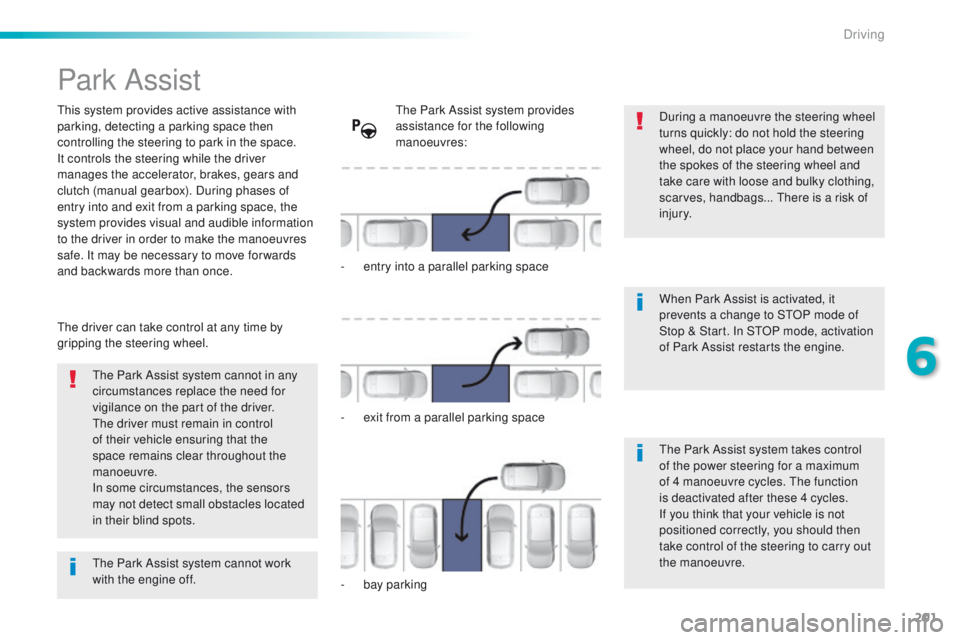
201
Park Assist
this system provides active assistance with
parking, detecting a parking space then
controlling the steering to park in the space.
It controls the steering while the driver
manages the accelerator, brakes, gears and
clutch (manual gearbox). During phases of
entry into and exit from a parking space, the
system provides visual and audible information
to the driver in order to make the manoeuvres
safe. It may be necessary to move for wards
and backwards more than once.During a manoeuvre the steering wheel
turns quickly: do not hold the steering
wheel, do not place your hand between
the spokes of the steering wheel and
take care with loose and bulky clothing,
scarves, handbags...
t
h
ere is a risk of
injury.
When Park Assist is activated, it
prevents a change to S
tO
P mode of
Stop & Start. In S
tO
P mode, activation
of Park Assist restarts the engine.
th
e Park Assist system cannot in any
circumstances replace the need for
vigilance on the part of the driver.
th
e driver must remain in control
of their vehicle ensuring that the
space remains clear throughout the
manoeuvre.
In some circumstances, the sensors
may not detect small obstacles located
in their blind spots.
th
e driver can take control at any time by
gripping the steering wheel.th e Park Assist system provides
assistance for the following
manoeuvres:
-
e
ntry into a parallel parking space
-
e
xit from a parallel parking space
-
b
ay parking
th
e Park Assist system takes control
of the power steering for a maximum
of 4 manoeuvre cycles.
t
h
e function
is deactivated after these 4 cycles.
If you think that your vehicle is not
positioned correctly, you should then
take control of the steering to carry out
the manoeuvre.
th
e Park Assist system cannot work
with the engine off.
6
Driving
Page 236 of 396
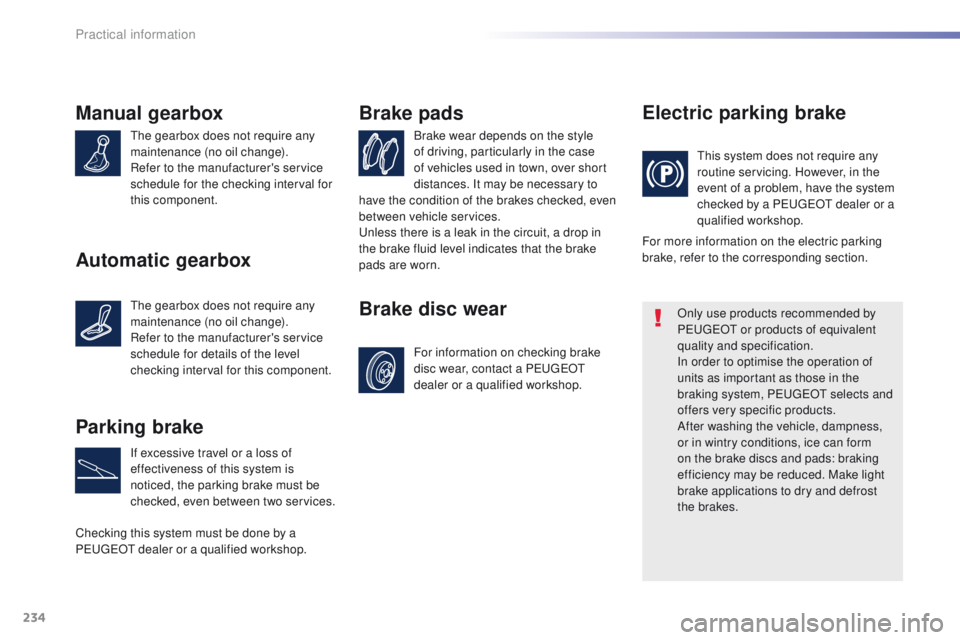
234
Manual gearbox
the gearbox does not require any
maintenance (no oil change).
Refer to the manufacturer's service
schedule for the checking interval for
this component.Brake wear depends on the style
of driving, particularly in the case
of vehicles used in town, over short
distances. It may be necessary to
Brake pads
For information on checking brake
disc wear, contact a Pe
ugeOt
dealer or a qualified workshop.
Brake disc wear Electric parking brake
this system does not require any
routine servicing. However, in the
event of a problem, have the system
checked by a P
e
uge
Ot
dealer or a
qualified workshop.
Only use products recommended by
P
e
uge
Ot
or products of equivalent
quality and specification.
In order to optimise the operation of
units as important as those in the
braking system, P
e
uge
Ot
selects and
offers very specific products.
After washing the vehicle, dampness,
or in wintry conditions, ice can form
on the brake discs and pads: braking
efficiency may be reduced. Make light
brake applications to dry and defrost
the brakes.
Parking brake
If excessive travel or a loss of
effectiveness of this system is
noticed, the parking brake must be
checked, even between two services.
Checking this system must be done by a
P
e
uge
Ot
dealer or a qualified workshop. have the condition of the brakes checked, even
between vehicle services.
un
less there is a leak in the circuit, a drop in
the brake fluid level indicates that the brake
pads are worn. For more information on the electric parking
brake, refer to the corresponding section.
Automatic gearbox
the gearbox does not require any
maintenance (no oil change).
Refer to the manufacturer's service
schedule for details of the level
checking interval for this component.
Practical information
Page 385 of 396
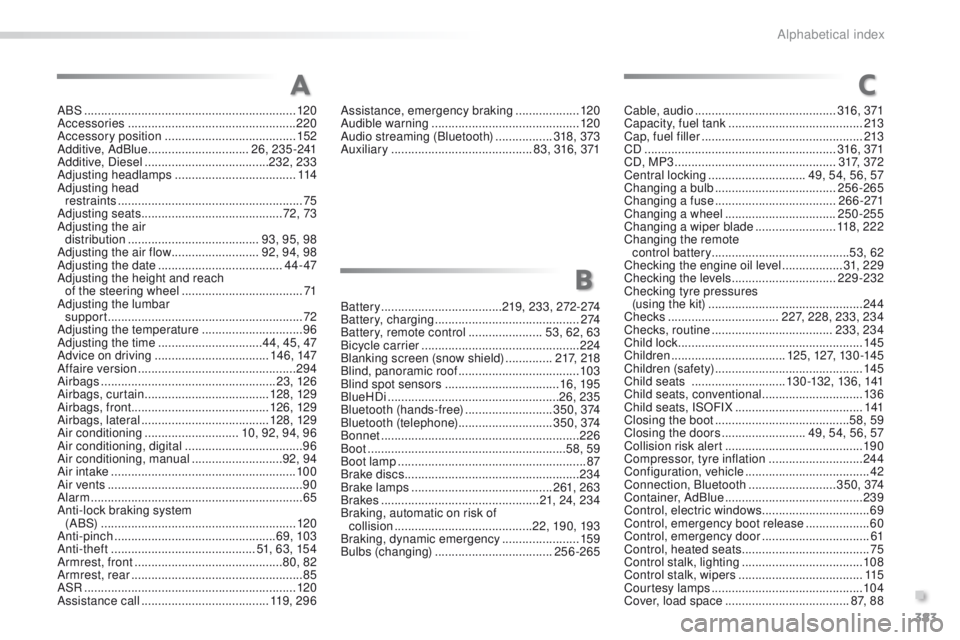
383
ABS ...............................................................120
Accessories .................................................. 220
Accessory position
....................................... 152
Additive, AdBlue
.............................. 26, 235-241
Additive, Diesel
..................................... 232, 233
Adjusting headlamps
.................................... 114
Adjusting head restraints
....................................................... 75
A
djusting seats
.......................................... 72, 73
Adjusting the air distribution
....................................... 9
3, 95, 98
Adjusting the air flow
..........................92, 94, 98
Adjusting the date
..................................... 4 4 - 47
Adjusting the height and reach of the steering wheel
....................................71
Adjusting the lumbar support
.......................................................... 72
Adjusting the temperature
.............................. 96
A
djusting the time
............................... 44, 45, 47
Advice on driving
.................................. 146, 147
Affaire version
............................................... 294
Airbags
.................................................... 23, 126
Airbags, curtain
..................................... 12
8, 129
Airbags, front ......................................... 126, 129
Airbags, lateral
...................................... 128, 129
Air conditioning
............................ 10, 92, 94, 96
Air conditioning, digital
...................................96
Air conditioning, manual
...........................92, 94
Air intake
....................................................... 10 0
Air vents
.......................................................... 90
Alarm
............................................................... 65
Anti-lock braking system (A BS)
.......................................................... 120
Anti-pinch
................................................ 69, 103
Anti-theft
........................................... 51, 63, 154
Armrest, front
............................................ 80, 82
Armrest, rear
................................................... 85
AS
R
............................................................... 120
Assistance call
...................................... 11 9 , 2 9 6Assistance, emergency braking ...................
12
0
Audible warning
............................................120
Audio streaming (Bluetooth)
................. 31
8, 373
Auxiliary
..........................................83, 316, 371
A
B
C
Battery .................................... 219, 233, 272-274
Battery, charging ........................................... 2 74
Battery, remote control
...................... 5
3, 62, 63
Bicycle carrier
............................................... 224
Blanking screen (snow shield)
.............. 21
7, 218
Blind, panoramic roof
.................................... 103
Blind spot sensors
.................................. 16, 195
BlueHDi
................................................... 26, 235
Bluetooth (hands-free)
.......................... 3
5 0 , 374
Bluetooth (telephone)
............................3 5 0 , 374
Bonnet
........................................................... 226
Boot
........................................................... 58, 59
Boot lamp
........................................................ 87
Brake discs
.................................................... 23
4
Brake lamps
.......................................... 261, 263
Brakes
............................................... 21, 24, 234
Braking, automatic on risk of collision
......................................... 22, 19 0, 193
Braking, dynamic emergency
.......................159
Bulbs (changing)
...............................
....256-265 Cable, audio
..........................................
316 , 371
Capacity, fuel tank
..............................
..........
213
Cap, fuel filler ................................................
213
CD
.........................................................
316 , 371
CD, MP3
................................................ 3
17, 3 7 2
Central locking
.............................
49, 54, 56, 57
Changing a bulb
....................................
256-265
Changing a fuse
....................................
2 6 6 -271
Changing a wheel
.................................
250-255
Changing a wiper blade
........................
118, 222
Changing the remote control battery .........................................53, 62
Checking the engine oil level
..................
31, 2 29
Checking the levels
...............................
229-232
Checking tyre pressures (using the kit) .............................. ................
244
Checks ............... ..................227, 228, 233, 234
Checks, routine
....................................233, 234
Child lock
...............................
........................145
Children
...............................
...125, 127, 13 0 -14 5
Children (safety)
...............................
.............145
Child seats
............................13
0 -132, 13 6, 141
Child seats, conventional
..............................13 6
Child seats, ISOFIX
......................................1
41
Closing the boot
........................................58, 59
Closing the doors
.........................49, 54, 56, 57
Collision risk alert
..............................
...........19 0
Compressor, tyre inflation
............................244
Configuration, vehicle
.....................................42
Connection, Bluetooth
..........................3 5 0 , 374
Container, AdBlue
.........................................239
Control, electric windows
................................69
Control, emergency boot release
...................60
Control, emergency door
................................61
Control, heated seats
......................................75
Control stalk, lighting
.................................... 10
8
Control stalk, wipers
.....................................115
Courtesy lamps
.............................................104
Cover, load space
.....................................87
, 88
.
Alphabetical index